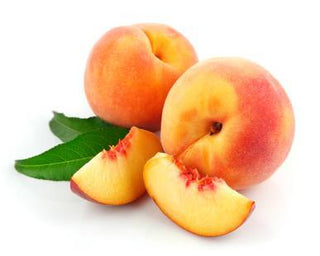(prunus persica)
The peach is quite possibly the sweetest, juiciest member of the rose family. All peaches, like apricots, plums and cherries, are classified as stone or drupe fruits because their flesh surrounds a hard center seed. In peaches, this seed is red-brown, oval shaped and surrounded by a wood-like exterior.
There are two major types of cultivated peaches, cling stones and freestones depending on whether or not the flesh sticks to the stone. Traditionally, cling stones are used for canning and freestones are sold fresh.
All peaches have a fragrant aroma and a velvety, delicate skin. Their flesh can be either white or deep yellow in color. White peaches are very sweet while their yellow counterparts have more acidity and tang in their flavor.
Originally cultivated in China over 12,000 years ago, peaches spread across the Asian continent to Persia where Alexander the Great discovered them. Spanish explorers brought peaches to the Americas in the 16th century where Native American tribes are credited with spreading peach trees across the nation. Although peaches were well-known by the 18th century (Thomas Jefferson grew peach trees at Monticello), United States farmers did not begin commercial production until the 19th century.
Although Georgia’s nickname is the “Peach state” and a large peach is emblazoned across every license plate, more than two-thirds of the U.S. peach crop is grown in California. The rest of the crop is spread between N. Carolina, Georgia, New Jersey, Pennsylvania and Washington. Outside of the United States, major peach producing countries include Iran, India, France, Italy, Spain, and Greece.
Nutrition
One large peach contains just 68 calories while boasting 3 grams of fiber. Due to their naturally sweet taste, a peach is concentrated in sugars, providing 15 grams of carbs.
When enjoying a peach, make sure to include the delicate skin – many of the nutrients can be found in this outer layer. If you choose to eat canned peaches, buy those canned in water (59 calories) or light juice (110 calories) instead of heavy syrup (194 calories) to reduce the calorie and sugar content.
Peaches are an excellent source of vitamin C, containing 11.6 mg or 19% of the suggested daily intake. A good source of niacin, vitamin K and vitamin E, a large peach contains about 7% of the suggested daily intake for each.
Peaches are a good source of vitamin A. One large peach contains 570 IUs or 11% of the suggested daily intake. The vitamin A in peaches comes primary from the carotenoids beta-carotene, beta cryptoxanthin, lutein and zeaxanthin. These carotenoids are responsible for giving peaches their deep orange-red color.
A large peach contains 333 mg of potassium or 10% of the suggested daily intake. Peaches are a source of copper and manganese, containing around 5% of the suggested daily intake.
Selection and Storage
Peaches are in season from May until October, so be sure to grab a few of these delicate, sweet treats before the season is over.
When selecting peaches, look for those that are a creamy yellow color with hints of red. The fruit should smell fragrant and be slightly soft to the touch. Avoid fruits that have bruising or blemishes. Choose golden peaches without any traces of green near the stem.
After you bring your peaches home, they are best left uneaten for a couple of days so they can fully ripen. The best way to ripen a peach is to place it in a paper bag on the counter for 1 to 3 days. Never store your peaches in a plastic bag or in direct sunlight. When the peach is ripe it will give off a sweet aroma and give slightly to gentle pressure.
After ripening, peaches can be stored in the refrigerator for up to 5 days. (Refrigeration is not recommended; it can lessen the flavor and taste of the peach.) Because peaches are so highly perishable, it is best to buy only as many as you plan to use.
Peaches are #4 on the Environmental Working Group’s Dirty Dozen list – the fruits and vegetables with the highest amount of pesticide use. For this reason, purchase organically grown peaches whenever possible. Whether organically or conventionally grown, be sure to wash the fruit carefully before consuming.
Recipes
Peaches are best enjoyed with the peel intact but if you must peel them for a recipe, your best option is to blanch the peach in boiling water for a minute and then plunge into ice water to cool, the peel should slip right off.
If you’re still holding on to those last days of Indian summer, try this delightful light favorite, Grilled Peaches over Arugula with Goat Cheese and Prosciutto. For a savory sweet meal sure to impress guests, try Spice-Rubbed Flank Steak with Spicy Peach-Bourbon Sauce. The peach nectar in the recipe can be found near the bottled juices in the grocery store. For dessert, try baking Sadie’s Simply Sweet Peach Pie. At a dinner party recently, our guests brought Sadie’s homemade peach pie. It was delicious!
Fun Facts
The ancient Chinese considered the peach a symbol of long life and immortality.

